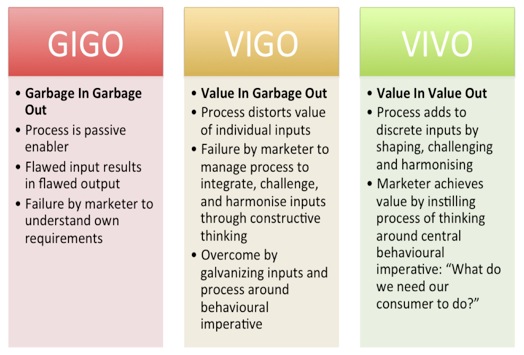Forget GIGO, marketing’s got a VIGO problem
Share

‘Garbage In Garbage Out’ (GIGO) has usefully served as a call to arms over the decades. Beware those who throw poor quality information into a business process because no matter how sophisticated that process, it can’t transform duds into studs. But even more concerning is what I call VIGO, AKA ‘Value In Garbage Out’. In other words, turning great inputs into ineffectual pulp. And all too often that is the bleak reality of promising marketing campaigns.
Let’s look at how to avoid the VIGO problem and how to instead ensure you deliver VIVO: Value In Value Out.
Slippery dip or pasta maker – what type of process do you manage?
In the Garbage In Garbage Out world, the process through which ideas pass is assumed to be inactive. No matter how good your brainstorming and sign off processes for example, a flawed idea will result in a flawed campaign.
To me this a bit like a playground slippery slide – you start in one place and end up in another a bit later, the experience will be either enjoyable or excruciating, but ultimately not much has changed. The slide might be an enabler, but it is ultimately passive.
In the Value In Value Out world, the process is instead an active one. Throughout the process, from identifying your objectives and intent, researching, briefing, receiving pitches, refining creative, socialising with stakeholders and signing off, you are having hard conversations, making the right decisions around inevitable compromises and seeking contrary rather than just confirmatory information.
This to me is more like a pasta maker. It starts with the raw dough being made ahead of time before it is then introduced to the pasta maker. From there it is constantly rolled and reformed until its state is transformed into something of value. And wow, it takes some time, grunt and perseverance!
In between the Garbage In Garbage Out slide and Value In Value Out pasta maker lurks the danger of Value In Garbage Out: the process that warps great ideas and churns out something that barely resembles what was intended. To me this is like the billiard table chute at the pub that croaks and clangs once you’ve potted your shot. Up on the table, there was a world of colourful possibility. However, once the ball is pocketed, and whether you potted the right or wrong ball, all you hear is the dull thud and slow roll down protracted and prescriptive alleyways before the ball sits inert ready for the next game.

Figure 1: Summary of GIGO, VIGO and VIVO
Why does value turn into garbage?
I believe value can turn into garbage due to one thing missing in the process – the behavioural imperative. The behavioural imperative is the action you want your market to take as a result of your campaign – the answer to the ‘So what do you want me to do?’ question. If this isn’t clear to you as the marketer, your agency, stakeholders and market, then your campaign will be garbage.
Value In Garbage Out campaigns are all around us. Take the WA Government’s ‘LiveLighter‘ anti-obesity ads for example, that provide shocking internal footage of what a fat gut comprises. Big on revulsion but leaving the target market short on answers about how to change their behaviour. Likewise, the anti-smoking ad that has smokers ‘nailing’ packets of cigarettes as they sit dimly lit and isolated in an empty factory. If I’m a smoker, what am I meant to do as a result? Contrast this with the ‘Stop smoking, start repairing’ Quitline ads that galvanise health benefits around the behavioural imperative; stop smoking.
A question of accountability
Value In Garbage Out is undoubtedly a key reason for campaign failure. However, where GIGO is a plain case of ineptitude, VIGO is an inexcusable result of intellectual laziness. It is a case of great input going begging because ‘life gets in the way’, or in the late Stephen Covey’s language, being too busy chopping wood to sharpen the saw.
If you’ve excused poor performance because you’ve been too busy, rushed to achieve an unrealistic deadline, had to appease stakeholders or been constrained by budget, chances are you have been VIGO’ed. And the bad news, it’s your fault.
You are the difference between GIGO, VIGO and VIVO.
Accountability for GIGO lies squarely at the input stage – the preserve of the marketer – so scapegoating your agency for not meeting the brief, stakeholders for messing with your objective or project management for not hitting deadline and budget is just not on because it’s simple: you have failed to understand how your inputs relate to your behavioural objective.
At the other extreme, accountability (and credit) for VIVO is also with the marketer. In this case though, you’ve understood how your inputs resolve your issue and what the campaign’s behavioural imperative is. You’ve kept everyone on track because you have been clear about what you need your market to do in response to the campaign.
So what about VIGO? That’s you again, although it sometimes doesn’t feel like it. Particularly in larger organisations it can be easy to let a process govern an outcome, so you have to remember that the process is there to produce the pasta, not pocket the ball.
No doubt being a marketer is a tough gig, and your outputs live in the public domain to be scrutinised, consumed or worst of all, ignored. My advice therefore is to keep it simple by focusing foremost on the central behavioural imperative. Do that and you should deliver a great outcome.















